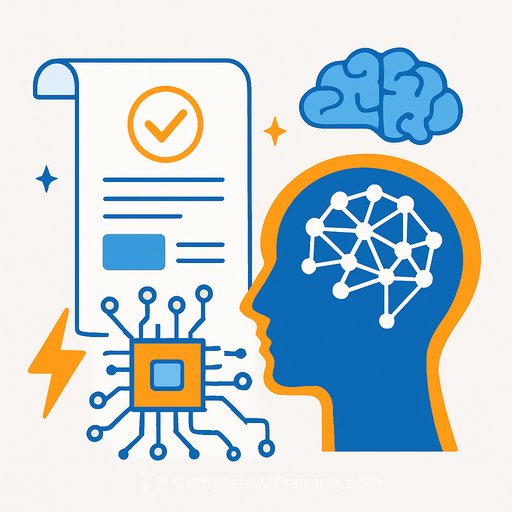Seeking AGI with artificial neurons that behave like real brain cells
Modern AI runs on streams of real-time data, but conventional chips are hitting physical limits on latency, bandwidth, and energy. Faster clocks and larger clusters help a bit, then stall. That's why more labs are shifting to neuromorphic hardware-systems that compute the way biology does. The bet: hardware that "thinks" like neurons could move us closer to artificial general intelligence (AGI).
Why build artificial neurons instead of faster software?
Most neuromorphic platforms simulate brain activity with math running on digital circuitry. Useful, but still bound by the same bottlenecks. The newer approach physically reproduces how neurons operate-using ions and diffusion, not just electrons and logic gates. That difference matters for energy, scale, and learning dynamics.
Diffusive memristors: neurons built from chemistry
Researchers at the University of Southern California report artificial neurons built around ion-based diffusive memristors. These devices move atoms (e.g., silver ions in oxide) to create thresholded spiking and state changes-closer to how biological neurons propagate signals. One published design implements a spiking neuron with one diffusive memristor, one transistor, and one resistor (1M1T1R), aligning with integrate-and-fire behavior and event-driven operation.
Because memory and computation are co-located, the device avoids constant data shuttling. The payoff is high-density arrays, lower energy per spike, and microsecond-scale responsiveness. In practice, that means more compute at the edge, less heat, and learning that doesn't need cloud-scale resources.
What this could mean for AGI research
- Event-driven learning: Local rules (e.g., spike timing) run directly in hardware instead of training everything offline.
- On-device adaptation: Systems can update from a handful of examples and stabilize quickly-ideal for robotics, prosthetics, and autonomous sensors.
- Energy efficiency: Lower switching energies and sparse spiking push inference and learning into power budgets that CMOS struggles to hit.
- Scalable density: Simple neuron primitives enable large arrays, encouraging brain-like architectures over sprawling von Neumann pipelines.
Practical checkpoints for labs and teams
- Measure energy per spike/event and end-to-end latency under realistic bursty inputs.
- Characterize device variability, drift, endurance, and retention across temperature and aging.
- Test local learning rules (e.g., STDP variants) in hardware with noisy sensory data.
- Prototype hybrid stacks: memristor neurons + CMOS control + event cameras or tactile sensors.
- Benchmark against tightly optimized digital baselines, not just default GPU training loops.
Integration with silicon, not a replacement
The near-term path is hybrid. Use diffusive memristor arrays for spiking, memory, and local plasticity, while standard silicon handles control, routing, and non-neural tasks. Crossbar arrays, compact neuron circuits, and analog front-ends can slot into existing design flows. The goal is to cut data movement, not abandon CMOS.
Related thread: protein nanowire neurons
Another group at the University of Massachusetts Amherst reports low-voltage artificial neurons using bacteria-grown protein nanowires. The appeal is direct bio-electronic coupling and sensors that work at body-friendly voltages. Potential uses include wearables that run on sweat, environmental monitors that scavenge power from humid air, and interfaces that communicate with living tissue.
Key open questions
- Device physics: How stable are ion dynamics over billions of cycles? What's the failure mode?
- Noise vs. computation: Can systems exploit stochasticity without losing reliability?
- Programming models: Which learning rules map cleanly to hardware without hand-tuned tricks?
- Manufacturing: Can processes scale with acceptable yield, uniformity, and packaging costs?
- Safety: How do we verify, audit, and constrain adaptive hardware in safety-critical settings?
Near-term applications worth piloting
- Edge perception: Event cameras + spiking neurons for low-latency vision on drones and small robots.
- Medical devices: Responsive neurostimulation with on-device adaptation and tiny power budgets.
- Industrial monitoring: Sparse, always-on anomaly detection in harsh or remote environments.
- Scientific instruments: High-throughput, low-latency feature extraction where bandwidth is scarce.
For background and further reading
If you're new to the hardware, this overview of memristors is helpful context: Memristor. For algorithm-hardware fit, see Spiking neural networks.
Skill-building for applied teams
If your roadmap includes spiking models, on-device inference, or compression for edge AI, structured courses can shorten setup time. Browse a curated set of current options here: Latest AI courses.
Bottom line: artificial neurons built from ion-driven devices move computation closer to biology, where learning and memory are local, sparse, and fast. If we want systems that learn from few examples and adapt in real time, this is a credible route-one we can evaluate with today's tools and datasets, not just theory.
Your membership also unlocks:






